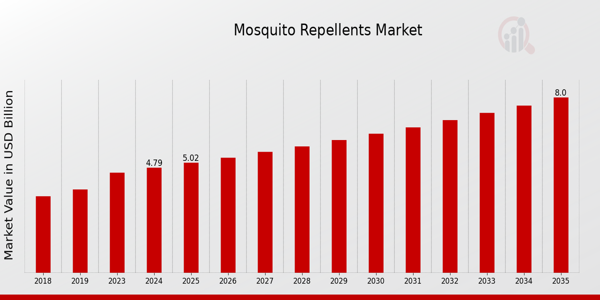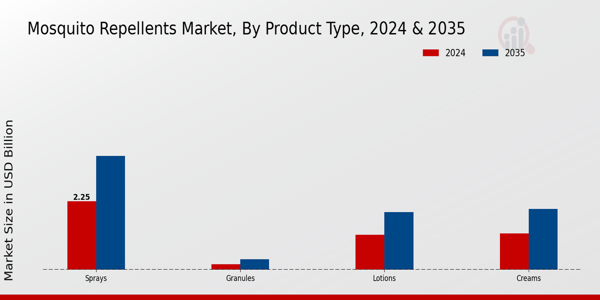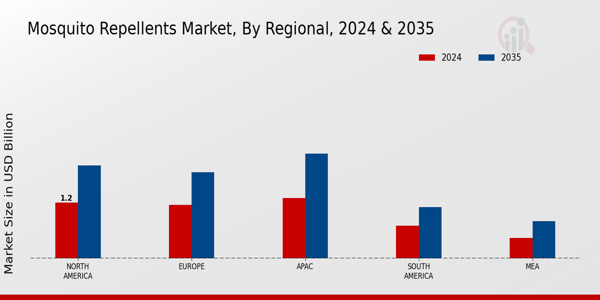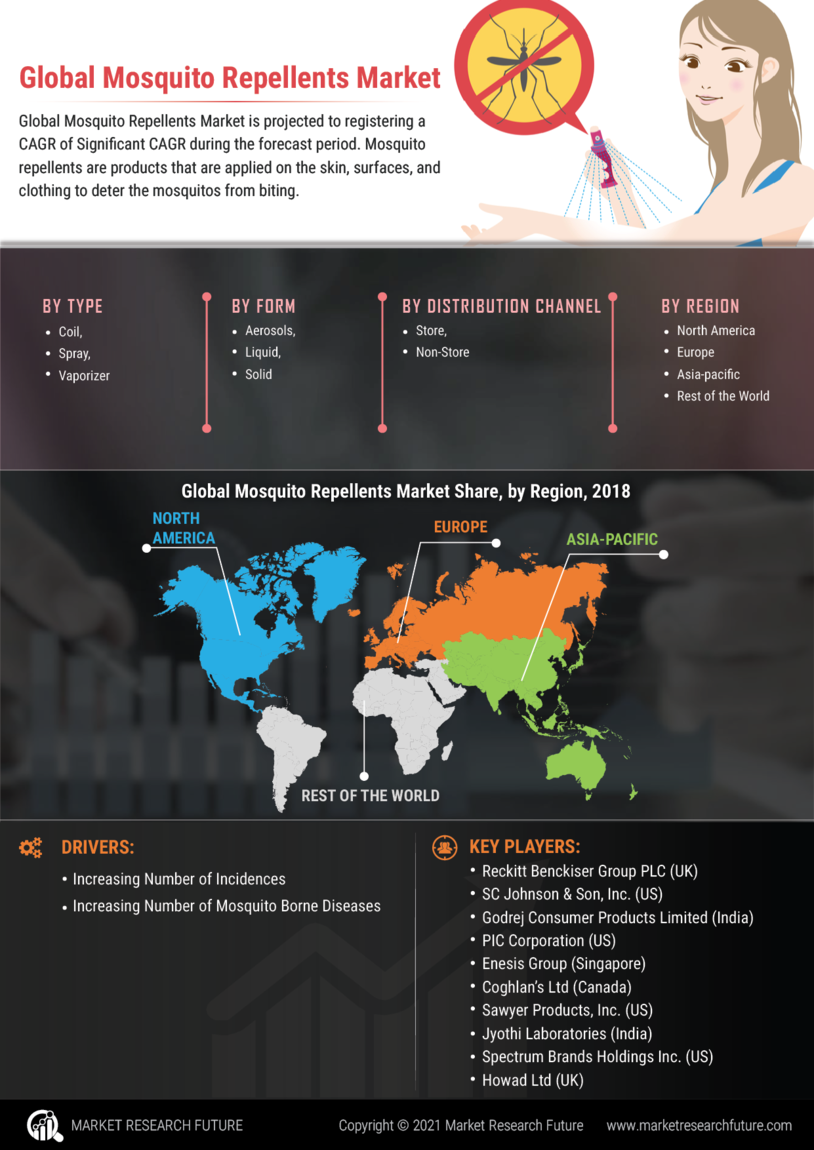Mosquito Repellents Market Summary
As per MRFR Analysis, the Global Mosquito Repellents Market is projected to grow significantly, driven by rising awareness of mosquito-borne diseases and a shift towards natural ingredients. The market was valued at 4.58 USD Billion in 2023 and is expected to reach 8.0 USD Billion by 2035, with a CAGR of 4.76% from 2025 to 2035. Key drivers include the increasing incidence of diseases like malaria and dengue, innovation in product formulations, and growth in the outdoor recreation sector. The market is characterized by a diverse range of products, including sprays, creams, and lotions, catering to varying consumer preferences.
Key Market Trends & Highlights
The Global Mosquito Repellents Market is witnessing transformative trends driven by health awareness and consumer preferences.
- Market Size in 2024: USD 4.79 Billion; Expected to reach USD 8.0 Billion by 2035.
- Sprays segment valuation in 2024: USD 2.25 Billion; Expected to grow to USD 3.75 Billion by 2035.
- Rising preference for natural ingredients: Over 75% of consumers prefer natural over synthetic.
- North America market valuation in 2024: USD 1.2 Billion; Expected to rise to USD 2.0 Billion by 2035.
Market Size & Forecast
2023 Market Size: USD 4.58 Billion
2024 Market Size: USD 4.79 Billion
2035 Market Size: USD 8.0 Billion
CAGR (2025-2035): 4.76%
Largest Regional Market Share in 2024: North America.
Major Players
Key Companies include Insect Shield, Pigeon Corporation, Ecolab, Kao Corporation, S.C. Johnson and Son, Spectrum Brands, Target Brands, Reckitt Benckiser, Cutter, Godrej Consumer Products, Thermacell, Coleman, and Madison Industries.

Key Mosquito Repellents Market Trends Highlighted
The Global Mosquito Repellents Market is experiencing several notable trends driven by increasing public awareness about mosquito-borne diseases such as malaria and dengue fever. This awareness has heightened demand for effective mosquito repellents globally. As countries continue to develop their healthcare systems and public health initiatives, especially in regions with a high incidence of vector-borne diseases, the need for preventive measures is becoming crucial. Eco-friendly and natural repellents are gaining traction as consumers become more conscious about the health impacts of chemical-based products. Brands are responding to this trend by formulating products with organic ingredients, which are perceived as safer for both individuals and the environment.
Urbanization and more travel have also led to more outdoor activities, which have created a lot of opportunities for new mosquito repellent products. The tourism industry, especially in tropical and subtropical areas, is pushing for better ways to protect people from mosquito bites. This is driving growth in this market. Online stores are also making it easier for more people to buy mosquito repellent, which increases the number of people who can buy it. Recent trends show that more people are using wearable mosquito repellents because they are easy to use and work well for people who are active. Also, as disposable incomes rise, especially in developing areas, people are more likely to buy better and more effective repellents.
The global response to climate change is also influencing this market, as shifting weather patterns can affect mosquito populations and their breeding grounds. Thus, manufacturers are focusing on research and development to create products that are effective in varying environmental conditions. As awareness grows, coupled with evolving consumer preferences and needs, the global mosquito repellents market is poised for continuous growth and development.
Mosquito Repellents Market Drivers
Increasing Global Risks of Vector-Borne Diseases
The rising incidence of vector-borne diseases such as malaria, dengue fever, and Zika virus is a significant driver for the Global Mosquito Repellents Market. According to the World Health Organization (WHO), approximately 2.7 billion people are at risk of malaria, with an estimated 229 million new cases in 2019 alone. This alarming statistic highlights the urgent need for effective mosquito repellent products to combat the spread of such diseases.
Organizations like the WHO and the Centers for Disease Control and Prevention (CDC) are actively promoting the use of mosquito repellents as a preventive measure, which fosters market growth. In addition, government initiatives globally are focusing on disease control, augmenting the demand for mosquito repellents as part of public health strategies.
Rising Awareness of Preventive Healthcare
Increased awareness regarding personal health and preventive measures is significantly contributing to the expansion of the Global Mosquito Repellents Market. Health campaigns led by organizations such as the American Public Health Association (APHA) emphasize the importance of using mosquito repellents, particularly in areas prone to mosquito-borne diseases. With a growing number of consumers becoming health-conscious, the demand for effective and safe mosquito repellents is surging.
This trend is further supported by several public health policies promoting the use of repellent across various regions, reflecting a proactive approach to healthcare.
Technological Innovations in Repellent Formulations
Technological advancements in the formulation of mosquito repellents are driving growth in the Global Mosquito Repellents Market. Companies are continuously innovating to create highly effective and safe products that cater to consumer needs. For instance, the development of natural and organic repellents, as noted by the National Pesticide Information Retrieval System (NPIRS), has gained traction, reflecting a shift towards eco-friendly options.
The growing inclination towards sustainable products aligns with global sustainability goals, encouraging both manufacturers and consumers to turn towards innovative mosquito repellent solutions. Such advancements are expected to increase market penetration and customer loyalty in the coming years.
Mosquito Repellents Market Segment Insights
Mosquito Repellents Market Product Type Insights
The Global Mosquito Repellents Market exhibits a versatile range of product types, crucial for catering to varying consumer preferences and needs. In 2024, the overall market is estimated to reach a valuation of 4.79 USD billion, highlighting the increasing demand for effective mosquito control solutions. Among the different product categories, Sprays are a dominant player, valued at 2.14 USD Billion in 2024, and projected to grow to 3.55 USD Billion by 2035. This substantial market share is attributed to their convenience and quick-acting properties, making them the preferred choice for many consumers.
Creams follow with a market valuation of 1.21 USD billion in 2024, increasing to 2.04 USD billion by 2035. The demand for creams is significantly driven by their skin-conditioning properties along with repellent effects, appealing to individuals who prioritize both skin care and protection from mosquito bites. Lotions, while smaller in market share, are positioned at 0.97 USD Billion in 2024, set to grow to 1.66 USD Billion by 2035, highlighting a steady consumer inclination towards lengthy protection periods without the greasy feel associated with some sprays.
Granules represent a niche segment, valued at 0.47 USD billion in 2024 and anticipated to reach 0.75 USD billion by 2035. Though they hold the smallest market share, granules are significant for their effectiveness in outdoor settings where they provide long-lasting protection against mosquito populations. Overall, the segmentation of the Global Mosquito Repellents Market into these distinct product types reflects diverse consumer preferences and the ongoing efforts to enhance mosquito control measures in various environments. The growth of these segments indicates a robust market trajectory, driven by increasing awareness of mosquito-borne diseases and the continuous innovation in product formulations to ensure user satisfaction and efficacy.
The statistics surrounding the market further discuss its potential trajectory, driven by a rising consumer base looking for mosquito protection that is both easy to use and effective. Each product type showcases its distinct advantages, impacting consumer behavior and preferences in the fight against mosquito-related health concerns.

Mosquito Repellents Market Active Ingredients Insights
The Active Ingredients segment within the Global Mosquito Repellents Market plays a critical role in enhancing the effectiveness of repellents. In 2024, the Global Mosquito Repellents Market was valued at 4.79 USD billion, showcasing the segment's significance as demand for effective mosquito control increases due to health awareness regarding mosquito-borne diseases. DEET remains a widely adopted active ingredient, known for its proven efficacy in repelling mosquitoes, while Picaridin offers a more user-friendly alternative with a lesser odor. IR3535 has gained traction among consumers seeking plant-based options, reflecting a growing trend towards natural products.
Oil of Lemon Eucalyptus has emerged as a popular choice, particularly in organic formulations, appealing to environmentally conscious consumers. As the Global Mosquito Repellents Market experiences growth driven by urbanization and changing climate patterns, the emphasis on effective active ingredients underscores their importance in product formulation. The insight around these active ingredients points to diverse preferences among consumers, with a strong focus on safety, effectiveness, and sustainability. This evolving landscape presents opportunities for innovation and expansion within the Global Mosquito Repellents Market, further highlighting the relevance of active ingredients in shaping the industry.
Mosquito Repellents Market Formulation Insights
The Global Mosquito Repellents Market, particularly in the Formulation segment, is experiencing noteworthy growth, valued at 4.79 USD billion in 2024 and projected to reach 8.0 USD billion by 2035. This segment has seen increasing diversification with the emergence of various formulations, including Chemical, Natural, and Biopesticides. Chemical formulations dominate the market due to their wide effectiveness and rapid action; however, there's a significant shift towards Natural options as consumers increasingly prefer eco-friendly solutions and are more conscious of health impacts.
Biopesticides are also gaining traction, driven by the growing awareness of sustainable agricultural practices and the need for safe pest control methods. With the Global Mosquito Repellents Market statistics showing a shifting focus towards environmentally friendly products, the interplay of these formulation types reflects market growth driven by consumer preferences, regulatory pressures, and increasing investments in Research and Development. As such, the landscape of the Global Mosquito Repellents Market is not only evolving with the introduction of innovative formulations but also aligning with broader global sustainability goals and environmental health concerns.
Mosquito Repellents Market End Use Insights
The Global Mosquito Repellents Market is experiencing significant growth, with its overall valuation expected to reach 4.79 USD Billion by 2024 and further increasing to 8.0 USD Billion by 2035. Within the market, various end use applications are critical contributors to this growth, notably within the Household, Commercial, and Agricultural sectors. The Household segment plays a crucial role, as consumers increasingly seek effective solutions to create pest-free environments at home. The Commercial segment is prevalent in sectors such as hospitality and tourism, where maintaining comfort is essential for customer satisfaction and retention.
In the Agricultural sector, the use of mosquito repellents helps to safeguard crops and livestock from vector-borne diseases, making it significant for food safety and production. This diverse segmentation reflects the varied applications of mosquito repellents across the globe, catering to different needs and emerging trends. The market growth will be supported by rising awareness about vector-borne diseases and increasing urbanization, which heightens the demand for effective repellents across all end use categories.
Mosquito Repellents Market Regional Insights
The Global Mosquito Repellents Market is anticipated to grow significantly across various regions, contributing to a total valuation of 4.79 USD billion by 2024. North America, valued at 1.15 USD billion, holds a major share in this market, driven by increasing awareness of mosquito-borne diseases. Europe follows closely with a valuation of 1.2 USD billion, spurred by stringent regulations and a growing demand for eco-friendly products. In the Asia Pacific region, the market is valued at 1.8 USD Billion, making it a significant segment due to high population density and tropical climates fostering mosquito breeding.
South America and the Middle East, and Africa represent smaller but crucial portions of the market, valued at 0.4 USD billion and 0.24 USD billion, respectively, where rising urbanization leads to increased mosquito exposure. The growth across these regions is fueled by factors such as urban expansion, changing climatic conditions, and increasing health awareness, with opportunities for innovation in formulation and packaging. Overall, the Global Mosquito Repellents Market segmentation reveals substantial regional variances that reflect diverse consumer needs and environmental challenges.

Mosquito Repellents Market Key Players and Competitive Insights:
The Global Mosquito Repellents Market has experienced significant growth driven by increasing consumer awareness concerning health risks posed by mosquito-borne diseases, rising incidences of diseases such as malaria and dengue, and an increasing preference for outdoor activities. This market encompasses a range of products, including repellents in spray, lotion, and electronic forms, catering to diverse consumer needs. The competitive landscape is characterized by a mix of established companies and emerging brands, each vying for market share through innovative product offerings and effective marketing strategies. The rising demand is prompting companies to introduce advanced formulations featuring natural ingredients, catering to the growing consumer trend towards environmentally friendly and safe repellent options, which is reshaping the competitive dynamics of this market.
Thermacell stands out in the Global Mosquito Repellents Market due to its innovative approach to mosquito control. The company has forged a strong market presence with its unique outdoor mosquito repellent solutions that utilize a variety of technologies, including portable and patio repellent devices. One of the significant strengths of Thermacell is its focus on providing user-friendly, portable products that offer effective protection against mosquitoes without the need for sprays or lotions. This convenience appeals to outdoor enthusiasts and households, contributing to the brand's popularity. Furthermore, Thermacell has garnered consumer trust through extensive research and positive efficacy claims, positioning itself as a leading player in this competitive market segment and solidifying its brand loyalty among consumers.
Newell Brands has established itself as a significant player in the Global Mosquito Repellents Market through a diverse product portfolio that includes both traditional and innovative repellent solutions. The company offers several well-known brands that are synonymous with quality and effectiveness, thus benefiting from a strong market presence in households globally. One of the key strengths of Newell Brands is its continuous commitment to research and development, leading to the introduction of advanced formulations and eco-friendly alternatives tailored to customer preferences. Additionally, the company has engaged in strategic mergers and acquisitions, bolstering its capabilities to expand its product range and market reach. This proactive approach ensures that Newell Brands remains competitive while catering to the evolving demands of the global consumer base in the mosquito repellent industry, allowing it to maintain a strong foothold in the market.
Key Companies in the Mosquito Repellents Market Include:
- Insect Shield
- Pigeon Corporation
- Ecolab
- Kao Corporation
- S.C. Johnson and Son
- Spectrum Brands
- Target Brands
- SC Johnson
- Reckitt Benckiser
- Cutter
- Godrej Consumer Products
- Thermacell
- Coleman
- Pestell
- Madison Industries
Mosquito Repellents Market Industry Developments
The Global Mosquito Repellents Market has been very active lately because more people are aware of mosquito-borne diseases and are spending more time outside after the pandemic. Thermacell released new outdoor repellent devices in September 2023 to make the experience better for users and provide better protection. Around the same time, Amway started selling plant-based repellents in some Asian markets, which showed that they were interested in eco-friendly products. Reckitt Benckiser said that Mortein sales went up in June 2023, which is when demand is highest in the summer. Ecolab, on the other hand, added more mosquito control services for businesses in 2023, especially in the hospitality and healthcare sectors. In August 2023, Godrej Consumer Products looked into ways to grow its insecticide business strategically, which showed that it was still focused on brands like Goodknight. Japan's Kincho launched resin-infused mosquito solutions in November 2022, which were in line with trends toward sustainability. The market keeps growing steadily, and online shopping and direct-to-consumer channels are important for making things easier to get around the world and increasing sales.
Mosquito Repellents Market Segmentation Insights
Mosquito Repellents Market Product Type Outlook
- Sprays
- Creams
- Lotions
- Granules
Mosquito Repellents Market Active Ingredients Outlook
- DEET
- Picaridin
- IR3535
- Oil of Lemon Eucalyptus
Mosquito Repellents Market Formulation Outlook
- Chemical
- Natural
- Biopesticides
Mosquito Repellents Market End Use Outlook
- Household
- Commercial
- Agricultural
Mosquito Repellents Market Regional Outlook
- North America
- Europe
- South America
- Asia Pacific
- Middle East and Africa
Report Scope
| Report Attribute/Metric Source |
Details |
| MARKET SIZE 2023 |
4.58(USD Billion) |
| MARKET SIZE 2024 |
4.79(USD Billion) |
| MARKET SIZE 2035 |
8.0(USD Billion) |
| COMPOUND ANNUAL GROWTH RATE (CAGR) |
4.76% (2025 - 2035) |
| REPORT COVERAGE |
Revenue Forecast, Competitive Landscape, Growth Factors, and Trends |
| BASE YEAR |
2024 |
| MARKET FORECAST PERIOD |
2025 - 2035 |
| HISTORICAL DATA |
2019 - 2024 |
| MARKET FORECAST UNITS |
USD Billion |
| KEY COMPANIES PROFILED |
Insect Shield, Pigeon Corporation, Ecolab, Kao Corporation, S.C. Johnson and Son, Spectrum Brands, Target Brands, SC Johnson, Reckitt Benckiser, Cutter, Godrej Consumer Products, Thermacell, Coleman, Pestell, Madison Industries |
| SEGMENTS COVERED |
Product Type, Active Ingredients, Formulation, End Use, Regional |
| KEY MARKET OPPORTUNITIES |
Natural and organic repellents demand, Innovative delivery mechanisms development, Growth in outdoor recreation activities, Rising awareness of vector-borne diseases, Increased consumer focus on sustainability |
| KEY MARKET DYNAMICS |
Increasing incidence of mosquito-borne diseases, Rising health awareness among consumers, Demand for natural repellents, Growth in outdoor activities, Expansion of e-commerce channels |
| COUNTRIES COVERED |
North America, Europe, APAC, South America, MEA |
Mosquito Repellents Market Highlights:
Frequently Asked Questions (FAQ) :
The Global Mosquito Repellents Market is expected to be valued at 4.79 USD billion by 2024.
The expected CAGR for the Global Mosquito Repellents Market from 2025 to 2035 is 4.77%.
In 2035, the Global Mosquito Repellents Market is expected to be valued at 8.0 USD billion.
By 2035, the Asia Pacific region is expected to dominate the Global Mosquito Repellents Market.
The market size for mosquito repellents in North America is expected to be valued at 1.15 USD billion by 2024.
Major players in the Global Mosquito Repellents Market include Thermacell, Reckitt Benckiser, and SC Johnson.
The sprays segment of the Global Mosquito Repellents Market is expected to be valued at 3.55 USD billion by 2035.
The market value of mosquito repellents in Europe is expected to be 1.2 USD billion by 2024.
Challenges may include regulatory hurdles and increasing competition among product manufacturers.
The Asia Pacific market segment is expected to experience significant growth due to rising demand and population increase.

















